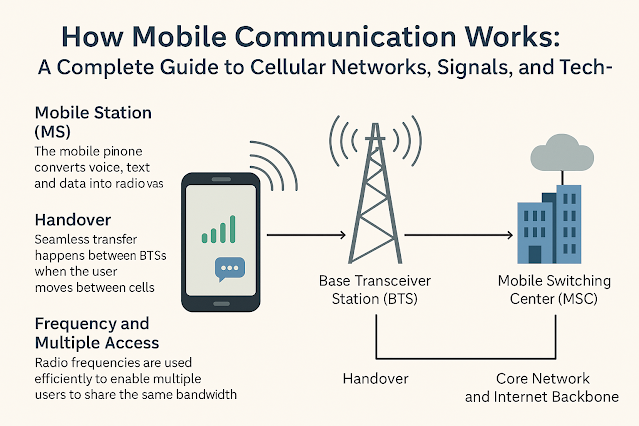This article breaks down the complex technology behind mobile communication into understandable parts, while still covering the technical foundations.
1. The Basic Concept of Mobile Communication
Mobile communication is the process of transmitting voice, data, or multimedia between two devices that are not physically connected, typically over a wireless network. It relies on radio frequency (RF) signals to transmit and receive information through the air.
2. Key Components of a Mobile Communication System
To understand how mobile communication works, let's explore its main building blocks:
a. Mobile Station (MS)
-
Your mobile phone or smartphone.
-
Contains a transceiver (transmitter + receiver), antenna, and a SIM card for user identity.
b. Base Transceiver Station (BTS)
-
Also called a cell tower.
-
Handles radio communication with the mobile phone.
-
Covers a specific area known as a cell.
c. Base Station Controller (BSC)
-
Controls multiple BTSs.
-
Manages handovers, power control, and frequency allocation.
d. Mobile Switching Center (MSC)
-
The brain of the network.
-
Connects calls, routes SMS, and interfaces with the public telephone network (PSTN).
-
Performs billing and authentication.
e. Core Network and Internet Backbone
-
Manages data services, packet switching, and connectivity to the internet or other networks (e.g., 4G EPC or 5G Core).
3. The Process: Step-by-Step
Let’s walk through what happens when you make a call or send a message.
Step 1: Signal Transmission
Your mobile phone converts your voice (analog signal) into digital data, then transmits it as modulated radio waves to the nearest BTS.
Step 2: Connection to the Network
The BTS forwards your signal to the BSC, which routes it to the MSC. The MSC decides:
-
Where to send the signal (local, national, or international)
-
Whether the recipient is in the same network or another one
Step 3: Routing to the Recipient
The MSC communicates with:
-
Another MSC (for mobile-to-mobile calls)
-
PSTN (for landline calls)
-
The Internet (for data services like browsing or VoIP)
The data is routed to the recipient's BTS, which transmits it wirelessly to the recipient’s phone.
Step 4: Handover (if moving)
If the user moves between cells (like during a call in a car), the network performs a handover:
-
Seamlessly switches to another BTS without interrupting the call.
-
Managed by the BSC or MSC depending on the handover type (intra- or inter-cell).
4. Frequency and Multiple Access Techniques
Mobile communication depends on:
-
Radio Frequencies (RF): Specific bands licensed to carriers.
-
Multiple Access Techniques:
-
FDMA: Frequency Division
-
TDMA: Time Division
-
CDMA: Code Division
-
OFDMA (used in LTE/5G): Orthogonal Frequency Division
-
These allow multiple users to share the same bandwidth efficiently without interference.
5. Cellular Architecture and Frequency Reuse
The mobile system is called "cellular" because it divides large areas into smaller cells:
-
Each cell has its own frequency range
-
Neighboring cells use different frequencies to avoid interference
-
Frequency reuse allows the same frequencies to be reused in non-adjacent cells, increasing capacity
6. Mobile Generations: Evolution of Technology
-
1G: Analog voice (1980s)
-
2G: Digital voice, SMS (GSM, CDMA)
-
3G: Mobile internet, video calls
-
4G (LTE): High-speed internet, VoIP
-
5G: Ultra-fast, low latency, IoT, massive device connectivity
-
6G (coming): AI-driven, terahertz frequencies, holographic calls
7. Data Communication in Mobile Networks
-
In 4G/5G, voice is also treated as data (VoLTE, VoNR).
-
Data is divided into packets, routed through the packet core network.
-
Devices use IP addresses to communicate across the internet.
FAQs: How Mobile Communication Works
Q1: How does my phone know which tower to connect to?
A: Your phone constantly listens for signals and connects to the BTS with the strongest signal (based on signal strength and quality metrics like RSRP and SINR).
Q2: What happens when there’s no signal?
A: It means your phone can’t reach any BTS—common in remote or underground areas, or when the signal is blocked by obstacles.
Q3: Is mobile communication secure?
A: Yes, modern networks use encryption and authentication to protect voice and data, especially in 4G/5G.
Q4: Why do calls sometimes drop while moving?
A: Call drops often occur due to handover failure, coverage gaps, or network congestion.
Q5: What is the role of a SIM card?
A: The SIM card stores your identity (IMSI), network keys, and enables your phone to authenticate and access the mobile network.
Conclusion
Mobile communication may seem like magic, but it’s all about radio waves, well-designed infrastructure, and smart protocols. As mobile networks evolve with 5G and beyond, they continue to push the boundaries of what's possible—offering not just calls and texts, but powering smart cities, autonomous vehicles, and future digital ecosystems.


